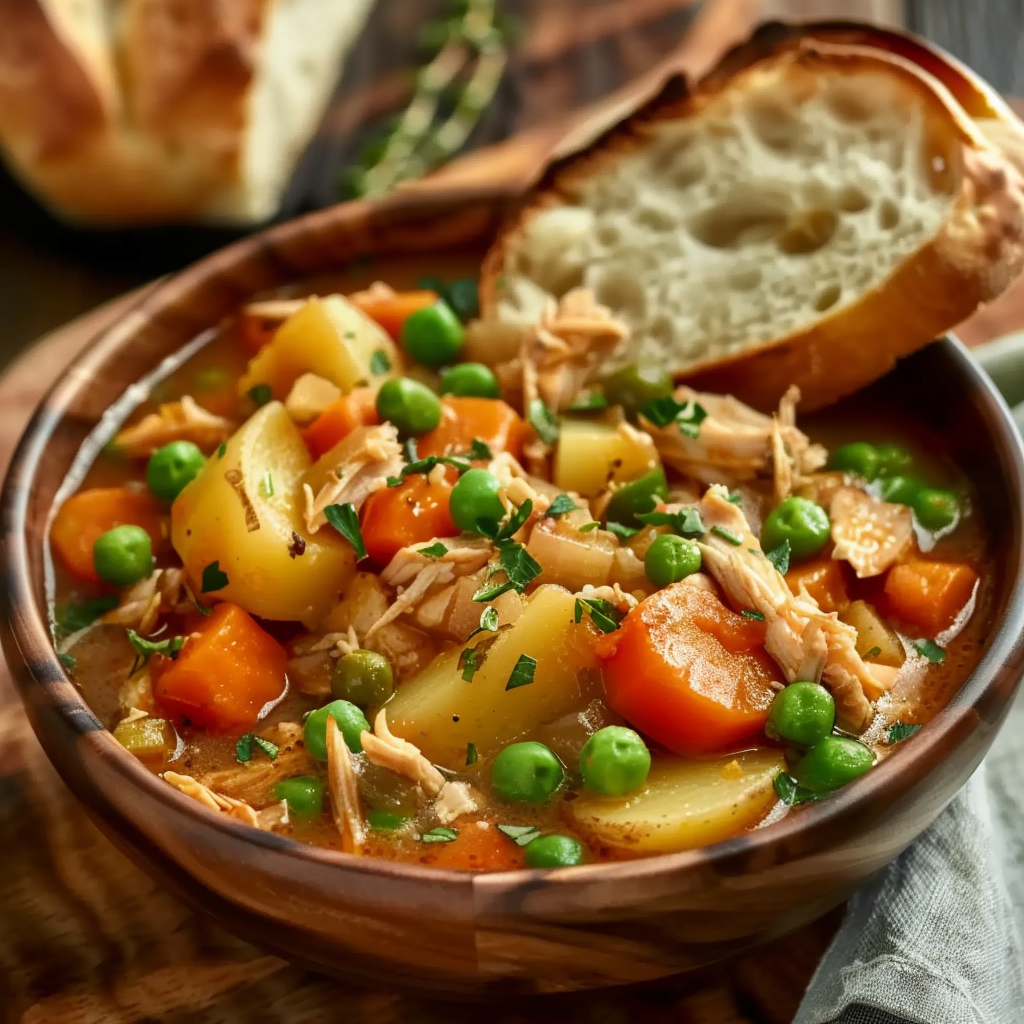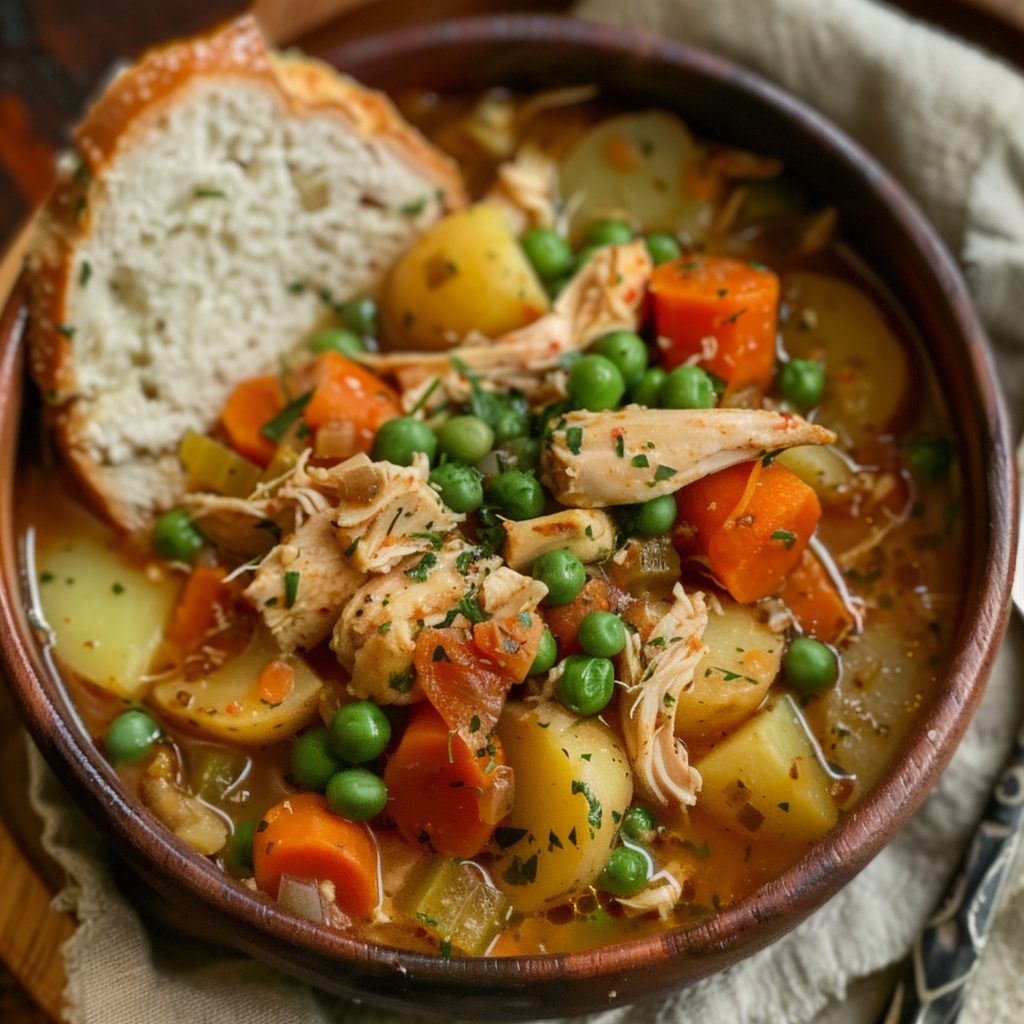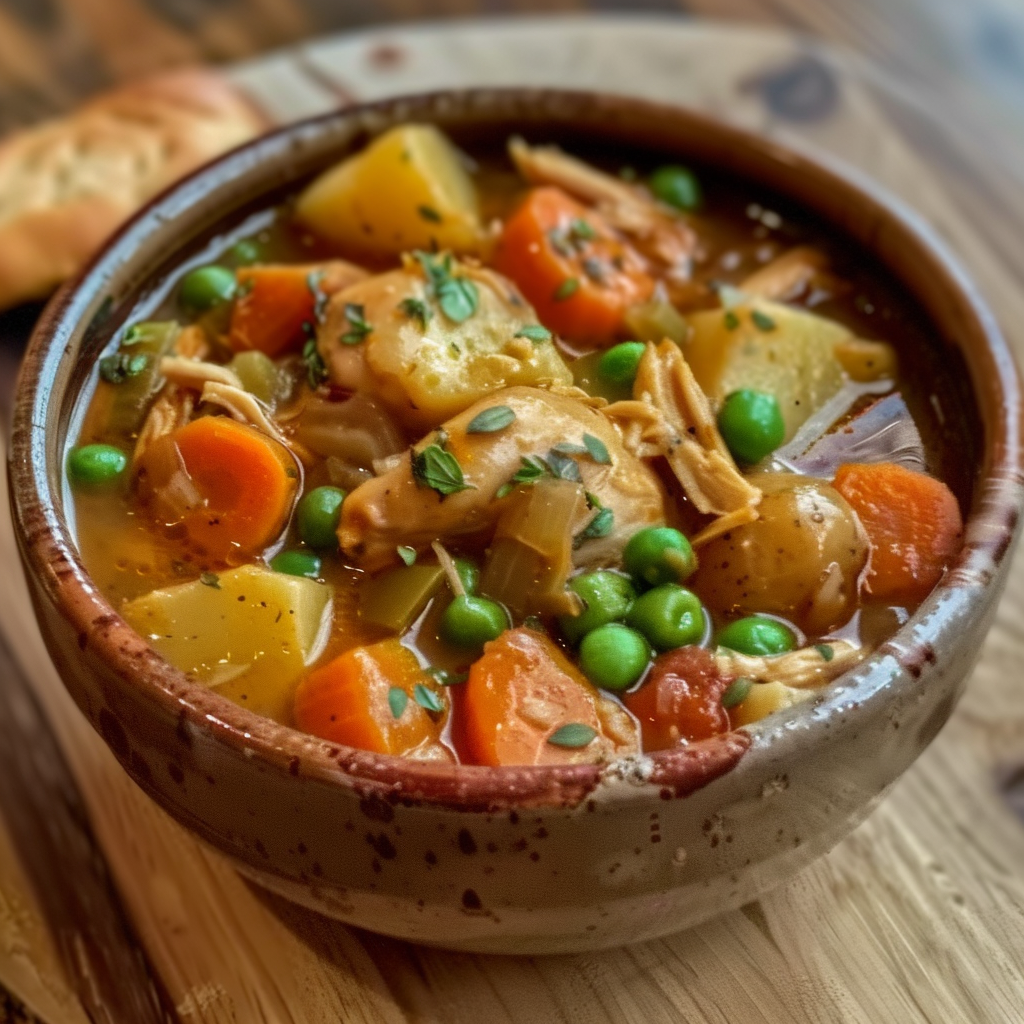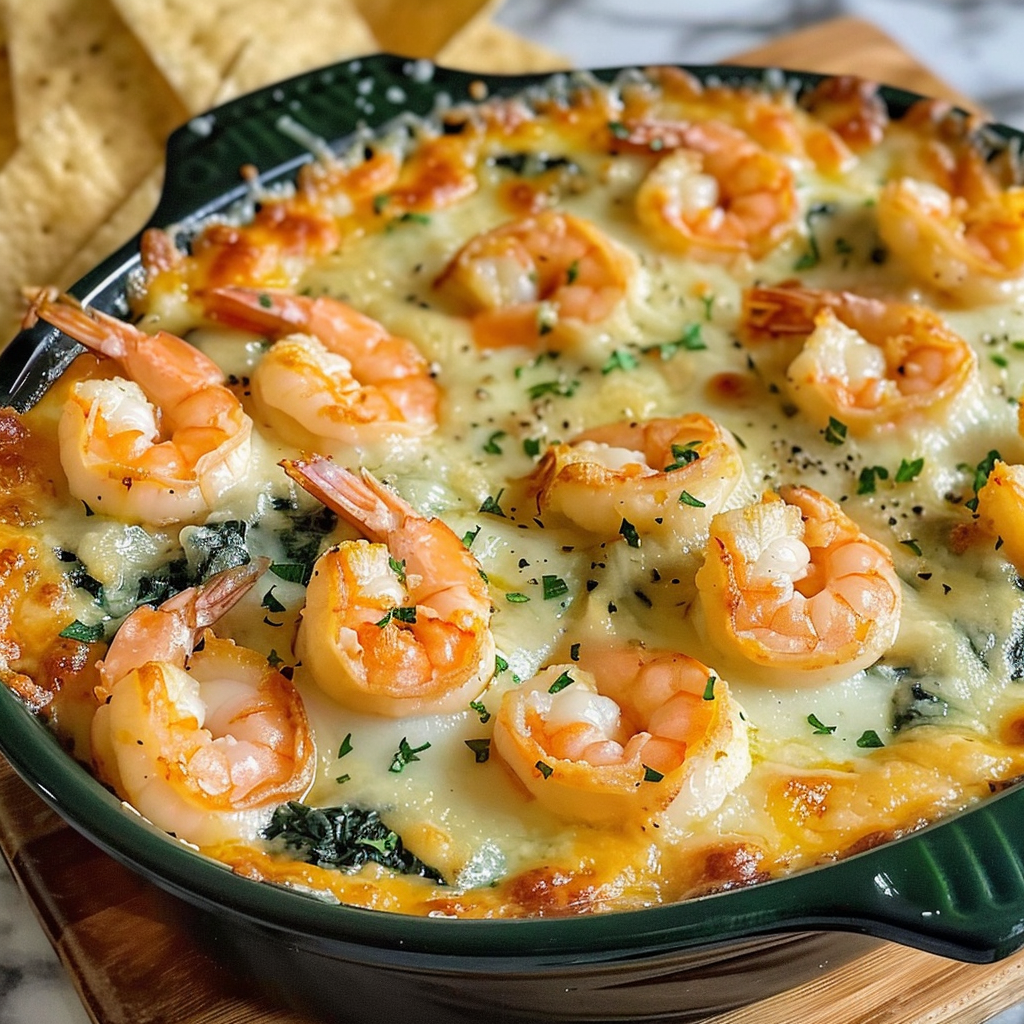Creamy Chicken Stew Soup
There’s nothing quite like a warm bowl of creamy chicken stew soup to soothe the soul on a cold evening. This hearty meal bridges the gap between a classic chicken soup and a thick stew, offering the best of both worlds. With tender chunks of chicken, flavorful vegetables, and a savory broth, it’s a one-pot meal that delivers on comfort, nutrition, and taste. Unlike traditional soups, this chicken stew offers a rich texture and satisfying bite, making it ideal for weeknight dinners or lazy Sunday meals.
Understanding the roots of this dish reveals why it’s such a beloved staple across cultures. Much like chicken soup, which has been celebrated for its healing and nourishing qualities, chicken stew offers the same comfort but with added substance. As a form of comfort food, this stew brings together wholesome ingredients and warming flavors that satisfy both hunger and emotion. It’s a dish that welcomes adaptation, making it easy to personalize based on what’s in your fridge or what’s in season.
This recipe also highlights the brilliance of building flavors from scratch. Starting with a mirepoix — the classic vegetable base of onion, celery, and carrots — creates a deep, aromatic foundation. From there, chicken broth, herbs like thyme and parsley, and slow simmering bring everything together in perfect harmony. For added inspiration, explore cozy dinner ideas on Pinterest’s comfort food boards, where variations of this dish showcase just how versatile and beloved it truly is.
This chicken vegetable stew is designed to be both nutrient-dense and easy to make, offering flexibility whether you’re cooking on the stovetop, in a slow cooker, or even preparing ahead for freezer meals. It’s also a wonderful meal prep option—one batch goes a long way, and the flavors only get better the next day. Whether you’re seeking a family favorite or a go-to recipe for chilly nights, this hearty chicken stew soup belongs on repeat in your weekly meal rotation.
What Makes This Chicken Stew Creamy and Hearty?
What sets this creamy chicken stew apart from a standard soup is its thicker, heartier consistency. While soups are generally broth-based and lighter, this stew leans into a velvety, rich texture that comes from the way ingredients are layered and cooked. It’s not overly heavy, but just thick enough to feel like a full, satisfying meal in one bowl.
The base of this stew starts with a generous amount of vegetables—carrots, potatoes, zucchini, and green beans—all of which naturally release starches and body into the broth. These root and non-root vegetables play a big role in enhancing both flavor and texture. You can learn more about these vegetables and their culinary roles in this guide to root vegetables, which also provides ideas for substitutions.
For richness, some variations of the recipe add ingredients like:
-
A splash of heavy cream
-
A spoonful of sour cream
-
A small amount of cheese, such as Parmesan or cheddar
Adding these near the end of cooking creates a silky finish, giving your stew that creamy quality without needing a full cream base. However, this step is optional—thanks to the natural thickness from the cooked vegetables and reduced broth, the stew holds its own in heartiness.
The use of boneless, skinless chicken thighs also contributes to the richness of the dish. Thighs offer more fat and flavor compared to breasts, though both work well depending on your preference. If you’re cooking in a slow cooker, thighs hold up better over long cook times and won’t dry out. You can find more ideas for cooking methods and stew variations on Pinterest’s cozy winter soups board, which showcases a range of similar dishes.
Finally, a bay leaf simmered in the broth adds a subtle depth of flavor, enhancing the stew’s complexity. This simple ingredient, often overlooked, brings aromatic richness. Learn more about its culinary use here.
All these elements—the vegetables, the seasoned broth, the chicken, and optional creamy add-ins—work together to create a well-balanced, satisfying dish that goes beyond the average soup. Whether you’re ladling it over rice, dipping in crusty bread, or enjoying it as-is, this creamy chicken stew soup is built to comfort and nourish.
Ingredients Breakdown and Substitutions
This chicken stew soup recipe thrives on simple, wholesome ingredients that work together to build a rich, comforting flavor. Each component plays a key role in the dish’s structure—bringing either depth, texture, or nutrition—and many can be swapped based on availability or dietary preferences.
Essential Ingredients
-
Chicken thighs or breasts: The recipe calls for 1½ lbs of boneless, skinless chicken thighs or breasts, chopped into bite-sized chunks. Chicken thighs are juicier and more flavorful, especially in slow cooking, but chicken breasts work well for a leaner option.
-
Olive oil: Used for browning the chicken and sautéing the vegetables. It adds healthy fat and enhances the stew’s richness.
-
Salt and black pepper: Foundational seasonings that should be added in layers for maximum flavor.
-
Onion and garlic: These aromatic ingredients are essential in any stew base. They create a savory depth and blend beautifully into the broth.
-
Carrots and celery: Form part of the classic mirepoix base, which is critical for building foundational flavor. These veggies also add color and texture.
-
Potatoes: Offer creaminess and body, helping thicken the stew naturally as they cook down. Yukon Gold or Russet potatoes are great options.
-
Zucchini: Adds a tender bite and balances heavier root vegetables. It cooks quickly and complements the stew’s earthiness.
-
Green beans: These give the stew freshness and snap, preventing it from becoming too dense.
-
Canned diced tomatoes (with juice): Add acidity and brightness, which cut through the richness of the broth and balance the dish.
-
Chicken broth: The backbone of this stew, chicken broth delivers savory, umami flavor. Use homemade or store-bought broth, and choose low-sodium if you prefer more control over seasoning.
-
Thyme, parsley, bay leaf: These herbs infuse the stew with warmth and fragrance. A single bay leaf added during cooking brings a subtle complexity.
Substitution Ideas
-
Protein alternatives:
-
Use rotisserie chicken for a quicker version—just shred and add it in the last 15 minutes.
-
Swap chicken for turkey or white beans for a vegetarian version.
-
-
Vegetable swaps:
-
Try sweet potatoes instead of white potatoes for a touch of sweetness and extra fiber.
-
Add in mushrooms, peas, or corn for extra depth and texture.
-
Leafy greens like kale or spinach can be stirred in during the final minutes for added nutrients.
-
-
Creamy additions:
-
Stir in heavy cream or coconut milk at the end for a velvety finish.
-
For a dairy-free option, coconut milk or oat cream works beautifully without overpowering the flavor.
-
-
Gluten-free adjustments:
-
The recipe is naturally gluten-free, but double-check your broth label to ensure no hidden gluten ingredients.
-
-
Low-carb modifications:
-
Reduce the potatoes or replace them with cauliflower florets for a lower-carb option.
-
This stew recipe is as flexible as it is delicious. Whether you want to experiment with seasonal vegetables or adapt for dietary needs, it can easily evolve while staying true to its comforting roots. For visual inspiration, check out this curated Pinterest board of chicken stew recipes, which showcases creative variations from home cooks around the world.
Cooking Methods – Stove Top vs. Slow Cooker
One of the great things about this chicken stew soup recipe is its adaptability across multiple cooking methods. Whether you prefer to make it quickly on the stovetop or let it slowly simmer in a crockpot, the outcome is the same: a rich, comforting dish packed with flavor and texture. Below are step-by-step instructions for both methods, along with notes on how to adjust ingredients and timing based on your chosen technique.
Stovetop Method
The stovetop version of this hearty chicken stew allows you to layer flavors by sautéing and simmering, giving you more control over texture and seasoning. It also comes together relatively quickly compared to slow cooking.
-
Sear the chicken: Heat olive oil in a Dutch oven or large soup pot. Season the chicken with salt and pepper, then brown it on both sides. Remove and set aside.
-
Build the base: In the same pot, sauté diced onions and minced garlic until translucent and fragrant.
-
Add vegetables: Stir in carrots, celery, potatoes, zucchini, and green beans. Cook for about 5 minutes, allowing the vegetables to release their natural flavors.
-
Combine ingredients: Return the chicken to the pot, then add diced tomatoes (with juice), chicken broth, dried thyme, parsley, and a bay leaf.
-
Simmer: Bring the stew to a gentle boil, then lower the heat and cover. Simmer for 35–40 minutes until the chicken is cooked through and the vegetables are tender.
-
Finish and serve: Remove the bay leaf. Taste and adjust seasoning with additional salt and pepper. For added creaminess, stir in a splash of heavy cream at the end.
This version allows you to control the consistency. If you’d like it thicker, use a slurry of flour and broth to thicken it slightly in the last 5–10 minutes of cooking.
Slow Cooker Method
Making chicken stew soup in a slow cooker is ideal for busy days. The extended cooking time allows all the ingredients to meld beautifully, resulting in deep flavor with minimal hands-on effort.
-
Layer ingredients: Add chopped onions, garlic, carrots, celery, potatoes, zucchini, and green beans to the bottom of the slow cooker.
-
Add chicken and liquids: Place seasoned chicken on top. Pour in the chicken broth and diced tomatoes, then sprinkle in thyme, parsley, and the bay leaf.
-
Cook:
-
On low for 6–7 hours
-
On high for 3–4 hours
-
-
Finish the dish: About 30 minutes before serving, remove the bay leaf and stir. If you want a creamy finish, this is the time to add a splash of cream or dairy-free alternative.
If you’re using frozen vegetables or cooked chicken, add them in the last hour to prevent overcooking. For additional help with slow cooking, explore this Wikipedia guide on using slow cookers, which outlines temperature settings and timing strategies.
For more serving ideas, especially for cozy nights, browse this Pinterest board for comfort food dinner ideas, where chicken stew is a recurring favorite.
Instant Pot Adaptation
If you’re short on time but still want slow-cooked flavor, the Instant Pot is a fantastic option.
-
Use the sauté function to brown the chicken and aromatics.
-
Add all other ingredients, seal the lid, and cook on High Pressure for about 10 minutes.
-
Let the pressure release naturally for 10 minutes, then quick-release the rest.
-
Stir in any cream or finishing touches after cooking.
This method is ideal for busy weeknights when you want a comforting meal without hovering over the stove. No matter how you choose to cook it, this creamy chicken stew soup is sure to become a staple in your rotation.
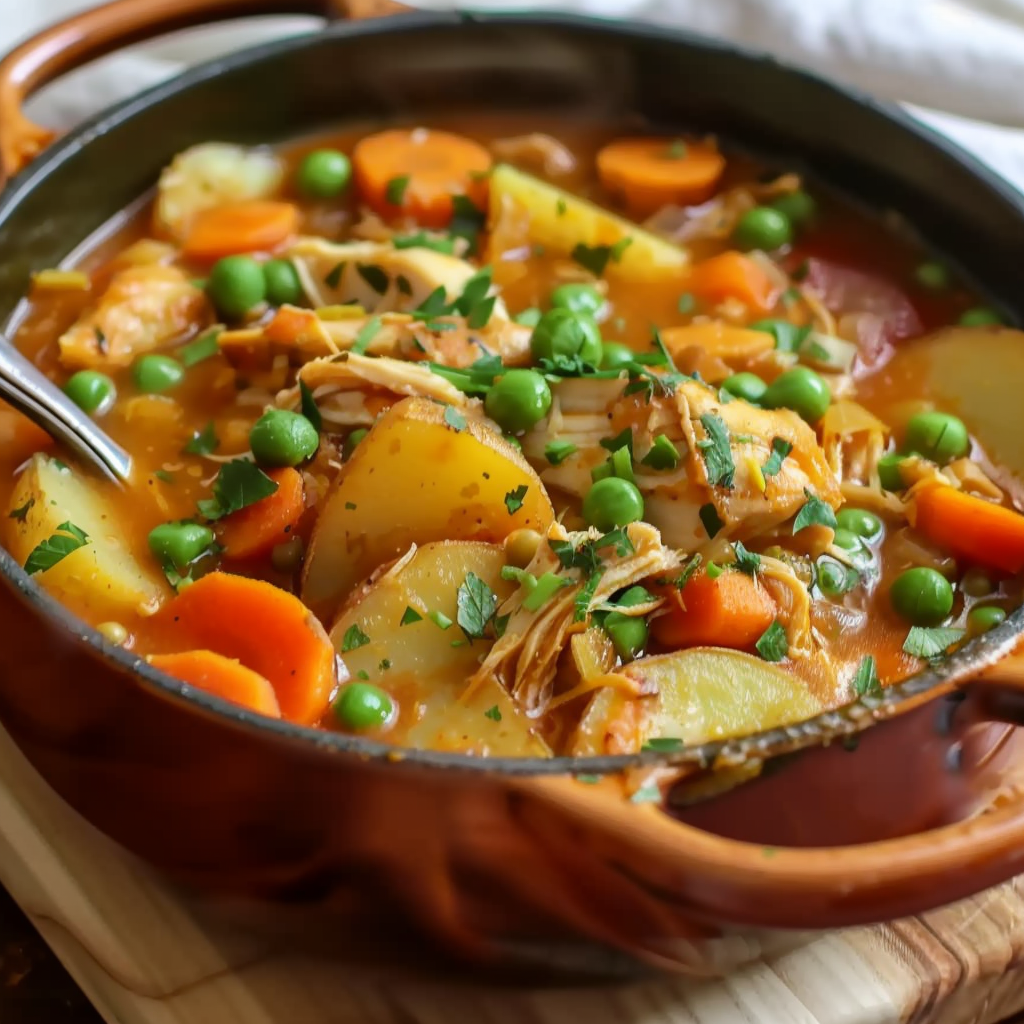
Texture and Flavor Tips
Perfecting the texture and flavor of your creamy chicken stew soup comes down to a few smart techniques and thoughtful ingredient choices. This section walks through essential tips to help you take your stew from good to unforgettable.
How to Achieve the Perfect Texture
-
Browning the chicken first adds richness and complexity. Don’t skip this step—it locks in flavor and helps develop the base of the stew.
-
Use starchy vegetables like potatoes to naturally thicken the broth as they break down during cooking. If you want an even thicker consistency, mash a few potato chunks into the stew just before serving.
-
Add a slurry of flour and broth (1 tablespoon flour + 2 tablespoons broth) to the pot near the end of cooking. Stir well and let simmer for 5–10 minutes until the stew thickens.
-
For an ultra-smooth finish, remove a ladleful of the stew, blend it, and stir it back in. This technique enhances creaminess without adding dairy.
How to Maximize Flavor
-
Layer seasonings as you go: season the chicken before browning, then taste and adjust throughout cooking. This helps build deeper flavor than adding everything at once.
-
Garlic and onions should be sautéed until soft but not browned—this draws out their sweetness without burning.
-
Simmer with a bay leaf, then remove it before serving. This herb adds a subtle bitterness that balances the richness of the broth. Learn more about its culinary use from this guide on bay leaf.
-
For more umami depth, add a splash of soy sauce or Worcestershire sauce (just ½ teaspoon) to the broth.
To ensure your dish doesn’t fall flat, taste as you go. Chicken stew is forgiving, and a little extra seasoning at the end can make a huge difference. For inspiration on seasoning ideas and finishing touches, explore Pinterest’s board on cozy winter soups, where you’ll find tips from home cooks around the world.
Serving Suggestions and Pairings
Once your creamy chicken stew soup is ready, the right sides and presentation can turn it into a complete, crave-worthy meal. Its thick, chunky texture means it can be served in a bowl like soup or ladled over a base like grains or bread.
Serve it with:
-
Crusty bread or dinner rolls – The stew’s thick broth is perfect for dipping. Try sourdough, a rustic baguette, or even cornbread.
-
Mashed potatoes – Pour the stew over a bed of creamy mashed potatoes for a double-comfort dish.
-
White or brown rice – Ideal for soaking up the flavorful broth.
-
Egg noodles or orzo – A classic pairing that turns the dish into a hearty pasta-style bowl.
-
Side salad – Lighten the plate with a crisp green salad tossed in a vinaigrette.
Kid-friendly serving tips:
-
Serve with cheesy toast or grilled cheese sandwiches.
-
Remove larger veggie chunks for picky eaters or blend part of the stew for a smoother consistency.
This stew’s versatility also makes it a great addition to a comfort food dinner menu. For inspiration on full-meal planning and visual presentation, check out Pinterest’s comfort food dinner ideas to create a table worth gathering around.
Make-Ahead, Storage & Reheating Tips
This chicken stew soup recipe is ideal for prepping in advance. The flavors deepen overnight, making leftovers even more delicious the next day.
Make-Ahead Tips:
-
Prep all your vegetables and cut your chicken in advance.
-
Store them in airtight containers in the fridge for up to 24 hours before cooking.
-
You can also brown the chicken ahead of time and store it separately.
Storage Instructions:
-
Store leftover stew in an airtight container in the refrigerator for up to 4 days.
-
For best results, let the stew cool completely before sealing to prevent condensation.
Freezing Tips:
-
This stew freezes beautifully. Transfer cooled stew into freezer-safe containers or zip-top bags, leaving some space for expansion.
-
Freeze for up to 3 months.
-
Avoid freezing if the stew contains added cream—dairy can sometimes separate. Instead, freeze it before adding cream and stir it in after reheating.
Reheating Tips:
-
Reheat on the stovetop over medium heat, stirring occasionally until hot.
-
Microwave in short intervals (1–2 minutes), stirring in between to avoid hot spots.
-
If it’s too thick after refrigeration or freezing, add a splash of water or broth to loosen it up.
Meal prepping this dish not only saves time, but ensures you always have a bowl of comfort food ready. For batch cooking strategies, explore chicken stew ideas on Pinterest for freezer-safe inspiration.
Variations of the Recipe
The beauty of this creamy chicken stew soup lies in how customizable it is. With a few tweaks, you can create endless versions suited to your taste or dietary needs.
Creamy Variations:
-
Add ½ cup of heavy cream at the end for a rich, smooth texture.
-
For a dairy-free option, use coconut milk—this adds subtle sweetness and is perfect for a tropical twist.
-
Stir in grated Parmesan cheese for added umami and creaminess.
Vegetable Add-ins:
-
Try corn, peas, or mushrooms for extra texture and flavor.
-
Stir in kale, chard, or spinach during the last 5 minutes for added nutrients.
Spicy Version:
-
Add red pepper flakes, chili powder, or a splash of hot sauce to introduce heat.
-
Sauté a diced jalapeño with the onions and garlic for deeper spice.
Grain & Legume Additions:
-
Mix in barley, quinoa, or cooked lentils for a fiber boost.
-
Swap potatoes for butternut squash or sweet potatoes for a fall-friendly twist.
Regional Variations:
-
Add cajun seasoning for a Southern U.S. spin.
-
Toss in some Mediterranean herbs like oregano and basil, and swap potatoes for chickpeas.
These adaptations ensure your chicken stew never gets boring. Use Pinterest comfort food dinner boards to explore how home cooks personalize their stews.
Health & Nutrition Considerations
Beyond comfort, this creamy chicken stew soup delivers on the nutrition front. It’s a balanced, whole-food meal that checks a lot of health boxes while remaining satisfying and flavorful.
Nutritional Benefits:
-
High in protein thanks to chicken, helping with satiety and muscle repair.
-
Rich in fiber from vegetables like carrots, celery, and green beans.
-
Low in sugar, especially if using unsweetened broth and fresh vegetables.
Lighten it up:
-
Use boneless skinless chicken breast for a leaner protein.
-
Skip the cream and use more blended veggies or broth for thickening.
-
Use low-sodium chicken broth to reduce salt content.
-
Swap starchy potatoes with cauliflower or zucchini for a lower-carb version.
Special diets:
-
Naturally gluten-free (just double-check your broth ingredients).
-
Easily made dairy-free by avoiding cream or using coconut milk.
-
For paleo or Whole30, use whole, unprocessed ingredients and avoid dairy and grains.
Learn more about the components of a nutrient-rich comfort meal on Wikipedia’s entry on comfort food.
Frequently Asked Questions (FAQs)
What is the difference between chicken stew and chicken soup?
Chicken stew is thicker and heartier than soup. It contains less liquid, and the broth is more concentrated with cooked-down vegetables and starches.
Can I make chicken stew in a crockpot?
Yes! The recipe is perfect for a slow cooker. Just layer your ingredients, set it to low for 6–7 hours or high for 3–4 hours, and enjoy.
How do you thicken chicken stew?
Use natural starches from potatoes, mash a few veggies into the broth, or stir in a flour or cornstarch slurry at the end. Blending part of the stew also creates a creamier texture.
Can you freeze creamy chicken stew?
Yes, but it’s best to freeze it before adding any dairy. Cream can separate when frozen, so add it only after reheating.
What can I add to chicken stew for more flavor?
Boost flavor with herbs like rosemary or oregano, a dash of Worcestershire or soy sauce, or a squeeze of lemon for brightness.
How long does chicken stew last in the fridge?
Store in an airtight container for up to 4 days. Reheat gently on the stove or in the microwave.

Creamy Chicken Stew Soup Recipe for Comfort Dinners
- Author: Naomi
Description
This Creamy Chicken Stew Soup is the ultimate comfort food, combining tender chunks of chicken, hearty vegetables, and a rich, flavorful broth. Perfect for chilly nights or weeknight dinners, this easy-to-make recipe can be prepared on the stovetop or in a slow cooker and customized with creamy or dairy-free variations. Thick like a stew, but cozy like soup, it’s a versatile, nourishing meal your whole family will love.
Ingredients
- 2 tablespoons olive oil
- 1 ½ lbs boneless, skinless chicken thighs or breasts, cut into chunks
- Salt and black pepper to taste
- 1 onion, diced
- 3 cloves garlic, minced
- 3 carrots, peeled and sliced
- 2 celery stalks, sliced
- 3 potatoes, peeled and cubed
- 1 zucchini, chopped
- 1 cup green beans, trimmed and cut
- 1 can (14.5 oz) diced tomatoes, with juice
- 4 cups chicken broth
- 1 teaspoon dried thyme
- 1 teaspoon dried parsley
- 1 bay leaf
Instructions
Heat olive oil in a large pot or Dutch oven over medium-high heat. Season chicken with salt and pepper, then add to the pot and cook until browned. Remove and set aside.
In the same pot, add onion and garlic. Cook for 2–3 minutes until fragrant and softened.
Add carrots, celery, potatoes, zucchini, and green beans. Stir and cook for another 5 minutes.
Return the chicken to the pot, then pour in diced tomatoes and chicken broth. Add thyme, parsley, and bay leaf.
Bring the stew to a boil, then reduce heat to low. Cover and simmer for 35–40 minutes, until vegetables are tender and chicken is cooked through.
Remove bay leaf. Taste and adjust seasoning with salt and pepper if needed.
Serve warm with crusty bread or on its own.
Notes
-
Use thighs for a juicier, more flavorful stew, but breasts work well for a leaner option.
-
Add cream or cheese at the end of cooking for extra richness.
-
For freezing, make the base without dairy and stir in cream after reheating.
-
Taste and season in layers—don’t rely on seasoning only at the end.
-
Make it your own with additional veggies, grains, or spice levels.
-
Perfect with crusty bread, mashed potatoes, or on its own.


